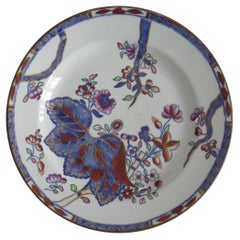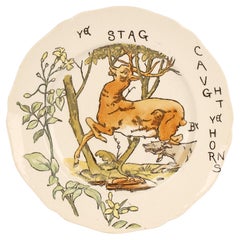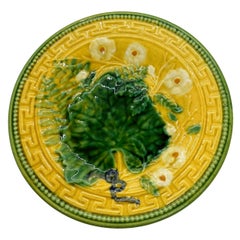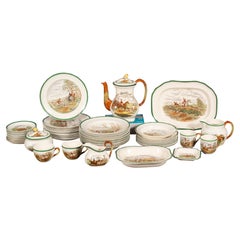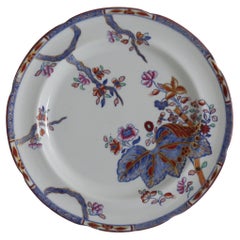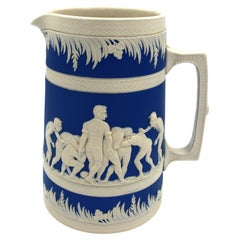Copeland Ceramics
to
2
2
2
1
1
2
2
2
2
2
2
2
14
318
206
184
131
Creator: Copeland
Copeland Spode Stone China Desert Plate Tobacco Leaf Pattern No. 2061, Ca 1865
By Copeland
Located in Lincoln, Lincolnshire
This is a good stone China (Ironstone) Desert Plate, hand painted in the tobacco leaf pattern, number 2061, made by the Copeland (Spode) factory in the 19th century, English Victoria...
Category
19th Century English Chinoiserie Antique Copeland Ceramics
Materials
Ironstone
Copeland Aesthetic Movement Stag Hunting Scene Plate, 1879
By Copeland
Located in Bishop's Stortford, Hertfordshire
An unusual antique Copeland Aesthetic Movement cabinet plate decorated with a titled stag hunting scene dated 1879. The large ceramic plate is of round sh...
Category
1870s English Aesthetic Movement Antique Copeland Ceramics
Materials
Ceramic
Related Items
French Majolica Plate, Leaf and Fern, Greek Key Border on Yellow, Choisy-le-Roi
By Choisy-le-Roi
Located in Banner Elk, NC
French Majolica (Barbotine) plate, leaf and fern, with blue ribbon and Greek key border on a yellow ground by Choisy-le-Roi, ca. 1880.
For thirty years, we have been among the world...
Category
19th Century French Victorian Antique Copeland Ceramics
Materials
Majolica
$95
H 0.25 in Dm 7.25 in
Copeland Spode Pottery Fox Hunt Lunch Service
Located in Essex, MA
A fox hunting set with all items listed below in the additional comments section.
Category
Early 20th Century English Copeland Ceramics
Materials
Pottery
French Faience Fish Head Plate Henriot Quimper, circa 1940
By Henriot Quimper
Located in Austin, TX
French faience fish head plate signed Henriot Quimper, circa 1940.
Category
1940s French Rustic Vintage Copeland Ceramics
Materials
Faience
Spode Pottery Neo-Classical Greek Pattern Blue Set of Dinner Plates-33 Plates
By Spode
Located in Downingtown, PA
Spode Pottery neo-Classical Greek Pattern blue set of dinner plates-33 plates
Zeus in His Chariot,
Early-19th Century
The Spode pottery underglaz...
Category
Early 19th Century English Neoclassical Antique Copeland Ceramics
Materials
Pearlware, Pottery
$9,000 / set
H 1 in Dm 9.75 in
French Faience Fish Head Plate Henriot Quimper, circa 1940
By Henriot Quimper
Located in Austin, TX
French faience fish head plate signed Henriot Quimper, circa 1940.
Category
1940s French Rustic Vintage Copeland Ceramics
Materials
Faience
19th Century Copeland Spode Greek Tazza
By Copeland Spode
Located in Fort Lauderdale, FL
A brightly colored Neoclassical tazza or cake plate in the 'Greek' pattern made by Copeland Spode in the late 19th century.
This tazza, in Copeland Spode’s ‘Greek...
Category
Late 19th Century British Neoclassical Revival Antique Copeland Ceramics
Materials
Earthenware, Pearlware
English Copeland Late Spode "Avondale" Water Pitcher
By Spode
Located in Chapel Hill, NC
Copeland Late Spode "Avondale" Water Pitcher, England. Earthenware pottery. Rococo Revival style decorated with baskets of flowers, flowers & trailing vines. Reg. No. 637555 design o...
Category
Late 19th Century English Rococo Revival Antique Copeland Ceramics
Materials
Earthenware, Pottery
Danish Modern Fish Hot Plate Ceramic by Porsgrund Norway Handpainted
By Porsgrund Porselænsfabrik
Located in San Diego, CA
Beautiful elegant Fish Hot plate circa 1950's, made in Norway handpainted in great condition with no chips or cracks.
Category
20th Century Norwegian Scandinavian Modern Copeland Ceramics
Materials
Ceramic
$140 Sale Price
20% Off
H 8 in W 5.5 in D 0.5 in
COPELAND SPODE - Greek Pattern Transfer Decorated Plate - U.K. - Circa 1956
By Copeland Spode
Located in Chatham, ON
COPELAND SPODE - Greek Revival transfer decorated ceramic cabinet plate in brown - featuring panels of Greek Gods and antique urns within a Greek key border - signed on the back (bac...
Category
Mid-20th Century English Greek Revival Copeland Ceramics
Materials
Ceramic
$206 Sale Price
30% Off
H 0.88 in Dm 10.13 in
Bone China bread plate with monochrome heritage print, made in Stoke-On-Trent
By Custhom
Located in London, GB
A section of the Palladian motif artfully and elegantly frames the rim of this soup bowl. The composition expresses a fully-formed Palladian window, the forms articulated in black leaving the frame to be defined as negative space bound.
Colour – Black on white.
Size – 8″ (20cm)
Composition – silk screen printed onto Bone China. Made in Stoke-on-Trent, England
Product Care
• Bone China can...
Category
2010s English Modern Copeland Ceramics
Materials
Cast Stone
$54
H 0.79 in Dm 7.88 in
Bone China Dinner Plate with Monochrome Heritage Print, Made in Stoke-on-trent
By Custhom
Located in London, GB
A section of the Palladian motif artfully and elegantly frames the rim of this soup bowl. The composition expresses a fully-formed Palladian window, t...
Category
2010s English Modern Copeland Ceramics
Materials
Cast Stone
$68
H 0.79 in Dm 11.03 in
Stoneware Clay Cup in Stone Colour Hand Cast in UK
By Custhom
Located in London, GB
The pieces are slip cast in London, made from stoneware in small batches. The hand painted details around the rim of each item in the collection is created by glaze in a complimentar...
Category
2010s English Modern Copeland Ceramics
Materials
Cast Stone
Previously Available Items
Copeland Spode Stone China Dinner Plate Tobacco Leaf Pattern No. 2061, Ca 1880
By Copeland
Located in Lincoln, Lincolnshire
This is a good stone China (Ironstone) large Dinner Plate, hand painted in the tobacco leaf pattern, number 2061, made by the Copeland (Spode) factory in the 19th century, English Vi...
Category
19th Century English Chinoiserie Antique Copeland Ceramics
Materials
Ironstone
Marked 1895 American Football Motif Ceramic Pitcher by Copeland
By Copeland
Located in Chapel Hill, NC
Marked 1895 American Football motif ceramic pitcher by Copeland for Jones, McDuffee & Stratton, Boston. A rarely found American market piece - glazed & matte finished, creamy white o...
Category
Late 19th Century American Late Victorian Antique Copeland Ceramics
Materials
Ceramic
19th C. Victorian English Copeland White Ironstone Rose & Thistle Jelly Mold
By Copeland
Located in Pearland, TX
A lovely antique 19th-Century Victorian English white ironstone jelly or pudding mold. Impressed maker's mark for Copeland. This beautiful mold...
Category
Late 19th Century English Victorian Antique Copeland Ceramics
Materials
Ironstone
H 6.5 in W 8 in D 6.5 in
Large 19th c. English Imari Polychrome Charger with Gilt Accents by Copeland
By Copeland
Located in Austin, TX
A large English Imari polychrome charger or round tray with raised edge around the circumference by the celebrated pottery firm, Copeland, c 1850 -1867, featuring a stylized Japonism...
Category
1850s English Anglo-Japanese Antique Copeland Ceramics
Materials
Ceramic, Pottery
Porcelain Saucer Dish by Copeland 'Spode' in Imari Fence Ptn No. 794, circa 1850
By Copeland
Located in Lincoln, Lincolnshire
This is a beautiful small saucer-dish in the Japanese inspired Imari Fence pattern number 794, produced by the Copeland - Late Spode factory and made of porcelain in the mid 19th cen...
Category
Mid-19th Century English Chinoiserie Antique Copeland Ceramics
Materials
Porcelain
19th Century English Blue and White Soup Tureen Copeland
By Copeland
Located in Austin, TX
Antique English blue and white soup tureen with the underplate signed Copeland.
Willow pattern.
Measures: Underplate / 14.5" on 10.5", H 1...
Category
1880s English Victorian Antique Copeland Ceramics
Materials
Ceramic, Faience
Set of Eight Copeland Spode Floral Polychrome Enamel Rimmed Soup Bowls
By Copeland
Located in Great Barrington, MA
These eight porcelain rimmed soup bowls demonstrate the best of both design worlds.
Incorporating a 19th century Imari motif with a modern combination ...
Category
Late 19th Century English Japonisme Antique Copeland Ceramics
Materials
Ceramic
Copeland ceramics for sale on 1stDibs.
Copeland ceramics are available for sale on 1stDibs. These distinctive items are frequently made of ceramic and are designed with extraordinary care. There are many options to choose from in our collection of Copeland ceramics, although white editions of this piece are particularly popular. If you’re looking for additional options, many customers also consider ceramics by Christopher Dresser, Doulton Lambeth, and Doulton Burslem. Prices for Copeland ceramics can differ depending upon size, time period and other attributes — on 1stDibs, these items begin at $363 and can go as high as $1,895, while a piece like these, on average, fetch $1,129.
Creators Similar to Copeland
Questions About Copeland Ceramics
- What is Spode Copeland?1 Answer1stDibs ExpertApril 5, 2022Spode Copeland is a brand of fine antique porcelain from Britain. The Spode company started in 1776, and was bought by the Copeland family early in the 1830s. Browse a collection of Spode Copeland porcelain pieces from top sellers on 1stDibs.
